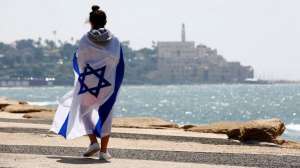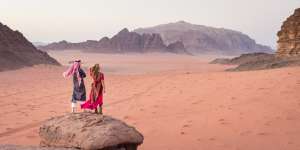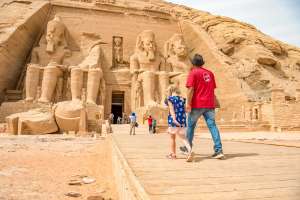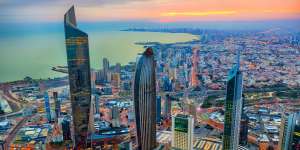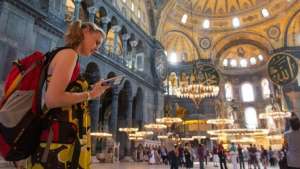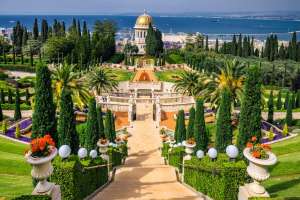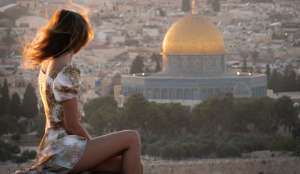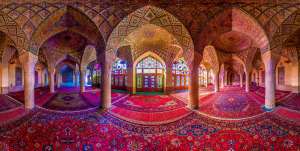Qatar is a country of striking contrasts and seamless harmony—a place where the golden dunes of the desert flow effortlessly into the mirrored glass towers of a futuristic cityscape. Perched along the calm waters of the Persian Gulf, this small peninsula has evolved into one of the Middle East’s most intriguing destinations. It’s a land where Bedouin traditions still echo in the call of the desert wind, even as cutting-edge architecture, world-class museums, and luxury shopping districts showcase its modern ambitions.
What makes Qatar so captivating is the balance it strikes between progress and heritage. Wander its historic souqs, and you’ll hear the hum of trade much as it sounded a century ago; step into the Museum of Islamic Art, and you’ll see how the nation guards its cultural soul while welcoming global influences. In Doha, ancient mosques stand within view of sleek skyscrapers, and the scent of oud mingles with the aroma of international cuisine wafting from waterfront cafés.

Beyond the capital’s glittering skyline lies another Qatar—vast deserts where camel caravans once roamed, coastal villages where pearl divers built their legacy, and beaches where the Gulf’s turquoise waves meet endless sands. Here, travelers find not only spectacular sights but a genuine warmth and rhythm that reveal a nation proud of its identity and open to the world.
Since gaining independence from Britain in 1971, the State of Qatar has carved out a remarkable place on the global stage. Fueled by its oil and gas wealth, it has transformed into a hub of art, education, and innovation, all while preserving the essence of its Islamic culture. Whether you come seeking adventure, history, or simple wonder, Qatar invites you to explore a story that bridges centuries—a journey from the heart of the desert to the future of the Persian Gulf.
Here are some of the most remarkable tourist attractions to visit in Qatar—each offering a glimpse into the country’s identity, history, and charm.
1. The Museum of Islamic Art

The Museum of Islamic Art, known locally as MIA, is one of Doha’s most iconic landmarks. Sitting gracefully at the end of the seven-kilometer-long Corniche, this museum feels almost like it’s floating on the water. Designed by the celebrated architect I. M. Pei, the museum occupies its own island near the traditional dhow harbor, blending perfectly with its serene surroundings. Two slender bridges connect it to the mainland, while the rest of its perimeter opens to the turquoise waters that reflect its geometric form.
The exterior is a masterpiece of simplicity—pure white stone under the sun, sharp angles softened by light and shadow. But inside, the building unfolds into layers of intricate detail, light-filled atriums, and winding staircases that seem to draw you into the history of Islamic civilization. Its galleries hold centuries’ worth of treasures—calligraphy, textiles, ceramics, metalwork, and manuscripts—from Spain to Central Asia. The museum’s setting, surrounded by MIA Park and the bay beyond, completes an atmosphere of tranquility and grandeur that perfectly mirrors Qatar’s fusion of tradition and innovation.
2. Doha Fort (Al Koot Fort)

In the very heart of Doha stands Al Koot Fort, more commonly known as the Doha Fort—a compact yet striking military fortress built in 1927 by Sheikh Abdulla bin Qassim Al Thani. What once served as a defensive structure now functions as a museum that tells the story of Qatar’s early days before the oil era transformed it forever.
Inside the fort, you’ll find exhibits of traditional Qatari life: wooden ornaments, fishing tools, ancient photographs, and paintings capturing daily routines from generations past. It’s an intimate space, where each room feels steeped in history. The thick whitewashed walls, crafted to withstand heat, create a cool refuge in the middle of the city’s bustle.
Standing before this fortress, you can imagine the Doha of a century ago—quiet streets, merchants, pearl divers, and the desert winds that once carried stories across the peninsula. For visitors seeking to understand Qatar’s soul beyond its modern skyline, Al Koot Fort is the perfect place to begin.
3. Barzan Towers

To the north of Doha, in the village of Umm Salal Mohammed, rise the elegant Barzan Towers—watchtowers dating back to the late 19th century. These tall, sturdy structures were part of a defensive network built to guard water sources and settlements across Qatar. Renovated in 1910 by Sheikh Mohammed bin Jassim Al Thani, the towers once kept a vigilant eye over the desert plains and, according to historians, may have also been used to observe the moon for determining Islamic calendar events.
Standing at about 16 meters tall, the Barzan Towers offer a wonderful example of traditional Qatari architecture. The thick mud walls, narrow staircases, and wind towers show the clever design principles that helped locals survive the harsh climate. Climbing to the top rewards visitors with sweeping views of the surrounding desert and villages—a panoramic reminder of how isolation and resilience have shaped Qatar’s identity.
Bring your camera—the golden light near sunset turns the towers into perfect silhouettes against the horizon.
4. The National Museum of Qatar

Few buildings in the world capture imagination like the National Museum of Qatar. Opened in 2019, this magnificent creation by architect Jean Nouvel was inspired by the natural desert rose formations found in Qatar’s arid soil. From above, the museum appears as a collection of interlocking discs—angular, overlapping, and beautifully chaotic—symbolizing the interwoven layers of Qatar’s history.
The museum sits beside the restored palace of Sheikh Abdullah bin Jassim Al Thani, a key figure in Qatar’s early statehood. Inside, the exhibits guide visitors through three main chapters: the natural history of Qatar, the beginnings of human settlement, and the rise of the modern nation. Multimedia installations, oral histories, and artifacts all blend to create an immersive experience that feels less like a museum visit and more like a journey through time.
Both inside and out, the structure is breathtaking—one of the most ambitious pieces of architecture in the Middle East and a proud statement of Qatar’s evolving cultural identity.
5. Inland Sea Beach (Mesaieed)

About 40 minutes from Sealine Beach lies Khor Al Adaid, more famously known as the Inland Sea—one of Qatar’s most magical natural wonders. It’s a rare place where desert dunes meet the ocean in a stunning union of sand and water. The drive there is an adventure in itself; you’ll navigate the soft dunes of Mesaieed, a thrilling experience that combines off-road excitement with otherworldly beauty.
The Inland Sea’s tranquility feels worlds away from the city’s fast rhythm. Visitors often camp here overnight, watching the sunset turn the dunes orange and the stars illuminate the dark sky above. Depending on the tide, the landscape changes dramatically—sometimes the sea pushes right into the desert valleys, and at other times, the sand stretches far into shimmering flats.
It’s no surprise that Khor Al Adaid is beloved by both locals and tourists. Whether you’re dune bashing with friends or quietly standing by the shore, this UNESCO-recognized biosphere is a reminder of nature’s quiet power in the heart of Qatar.
6. Al Jassasiya Carvings

To the northeast of Doha lies one of Qatar’s most mysterious sites: Al Jassasiya, an open-air gallery of ancient rock carvings. Discovered in the 1950s, this site contains nearly 900 petroglyphs—carved symbols and shapes etched into limestone outcrops that stretch across two parallel ridges. Their origin remains uncertain, and their meanings continue to puzzle archaeologists.
The carvings depict geometric patterns, boats, animals, and floral motifs, some centuries old and remarkably well-preserved. As you wander among these engravings, you get a sense of the early inhabitants’ connection to the sea and their environment. The site’s raw simplicity and historical depth make it an essential stop for anyone fascinated by Qatar’s prehistoric past.
Standing there, surrounded by silent hills and the wind whispering across the stone, you can almost imagine the artists who once knelt here, chiseling symbols that have outlived empires.
7. Al Zubarah Fortress

Set against a backdrop of endless desert north of Doha, Al Zubarah Fort rises as one of Qatar’s most iconic heritage sites. Built in 1938 by Sheikh Abdullah bin Jassim Al Thani, the fort originally served as a military outpost and later a coast guard station before being converted into a museum.
Nearby lies the archaeological site of the ancient Al Zubarah town, once a thriving pearl trading port during the 18th and 19th centuries. Today, both the fort and the surrounding ruins are recognized as a UNESCO World Heritage Site, preserving the memory of Qatar’s pre-oil economy and maritime legacy.
The fortress itself is a masterpiece of minimalism—thick sand-colored walls, high watchtowers, and a quiet courtyard that echoes with history. Visitors who make the journey here often speak of its solitude and the feeling of stepping into another era. It’s a perfect escape for travelers looking to glimpse the country’s distant past in an untouched setting.
8. The Doha Desert

The Doha Desert offers one of the most thrilling experiences in Qatar—a place where adventure and serenity coexist. Just beyond the city limits, the desert stretches out in soft golden waves, each dune sculpted by the wind into smooth, sweeping curves. For many travelers, a desert safari here becomes the highlight of their trip.
Whether you choose a fast-paced ride in a 4x4 or a slower camel trek, the sense of vastness is humbling. The silence, broken only by the wind, brings a strange peace. As sunset falls, the sands shift in color from gold to amber to violet, and the entire horizon glows.
You can join guided tours that include sandboarding, falcon demonstrations, and traditional Bedouin dinners under the stars. The Doha Desert isn’t just a place—it’s an experience that captures the timeless beauty and spirit of Qatar’s landscape.
9. State Grand Mosque (Imam Muhammad ibn Abd al-Wahhab)

Set on a low rise just south of the Corniche, the State Grand Mosque dominates the skyline with its long arcades, pale stone, and dozens of domes. Renamed in honor of the 18th-century scholar Imam Muhammad ibn Abd al-Wahhab, it blends traditional Gulf craftsmanship with contemporary scale: broad courtyards, clean lines, and a minaret that serves as a visual anchor from many parts of the city.
Step inside and your eyes lift instinctively—the ceiling soars, supported by simple white columns and understated chandeliers. The prayer hall is vast yet serene, designed to hold thousands while keeping sound soft and clear. By day the stone keeps the interior cool; by night, the exterior glows in a gentle wash of light. Non-Muslim visitors are welcome during designated hours when not in use for prayer, and modest dress is expected. Even if you only admire it from outside, the mosque’s rhythm of arches and domes makes a lasting impression.
10. Katara Mosque

Tucked within Katara Cultural Village, the Katara Mosque is a jewel box of mosaic and geometry. Its exterior shimmers in shades of turquoise, indigo, and deep plum, while three slender spires point cleanly into the sky. Designed with influences from celebrated mosques across the Muslim world, the building feels both familiar and refreshingly original.
The interior detailing rewards slow looking: calligraphic bands, floral tiles, and a mihrab that seems to glow. Come at golden hour when the tiles pick up the changing light and the surrounding courtyards hum with families heading to performances and cafés. It’s a small space compared to the State Grand Mosque, but artistically it punches far above its size.
11. Doha Corniche

The Corniche is Doha’s seven-kilometer waterfront promenade and the city’s social living room. Joggers and cyclists take it at sunrise; families and photographers return at sunset for the skyline view—glass towers mirrored on the bay, dhows drifting by, and the Museum of Islamic Art anchoring one end.
As the city expanded, so did the Corniche’s role. National celebrations, sports days, outdoor festivals—many spill onto this curved ribbon of walkway and parks. Pack water and stroll a section rather than trying to “do it all” at once. If you’re short on time, aim for the stretch between MIA Park and the Sheraton area for classic postcard angles.
12. Souq Waqif

Souq Waqif, rebuilt in traditional style after a 2000s restoration, is the atmospheric heart of old Doha. Narrow lanes open to small courtyards; scent clouds of cardamom and saffron drift past tailors, drums, and oud shops. You’ll find embroidered abayas, antique-style brasswork, spices, perfumes, and the kind of trinkets that make perfect suitcase gifts.
Go in the evening when the heat eases and the cafés fill. Order fresh bread from the tandoor, try a simple kebab plate, or settle in for tea while the world walks past. Prices range from bargain to boutique; for common items, compare a few stalls and don’t be shy to bargain politely. The souq is also a reliable launch point to nearby sights like the Corniche and the Museum of Islamic Art.
13. Falcon Souq

Adjacent to Souq Waqif, the Falcon Souq offers a window into a revered Gulf tradition. Rows of hooded falcons perch calmly while trainers discuss equipment, care, and the finer points of the sport. There’s a small arena for demonstrations at set times, and shops selling everything from leather hoods to GPS trackers.
Prices vary widely—these birds can cost more than a new car—so most visitors simply observe, ask questions, and take in the ritual. It’s one of those experiences that shifts your sense of place: modern city outside, centuries of falconry culture alive inside.
14. Aspire Park

Spread across 88 hectares in Aspire Zone, Aspire Park is Doha’s green lung—lawns, shaded paths, children’s playgrounds, and a rare natural-style lake all wrapped around views of the 300-meter Torch Tower. Weekends bring picnic blankets and footballs; weekday evenings are for joggers and families escaping the last heat of the day.
If you’re traveling with kids, this is one of the easiest wins in the city. For adults, the trail network and gentle landscaping make it a good recovery day stop between museum hopping and desert adventures. When the tower lights up after dark, the park takes on a calm, cinematic feel.
15. Katara Cultural Village

Katara was conceived as a showcase for art and heritage, but it’s also a place to simply wander. Amphitheaters, galleries, artisan spaces, a beach, and pocket cafés are set among alleys styled like a traditional fareej. On any given week you might find a film screening, a literature event, a crafts market, or a music performance.
Come with loose plans. Duck into a gallery, follow the sound of an oud to a courtyard recital, then finish with ice cream along the promenades. Between the cultural programming and the architecture, you’ll leave with a fuller sense of how Qatar invests in the arts.
16. The Pearl-Qatar

The Pearl is an artificial island built off West Bay—marinas curled like commas, waterfront promenades, and a cluster of high-end boutiques and cafés. It also holds significance as the first area where freehold property became available to foreign buyers.
For visitors, the appeal is simple: a stroll along the marina, a coffee overlooking yachts, and a slice of Doha’s modern coastal lifestyle. Even if luxury shopping isn’t your aim, neighborhoods like Porto Arabia and Qanat Quartier (with its pastel facades and small bridges) make for an easy afternoon walk and good photos.
17. Islamic Cultural Center (FANAR)

Recognizable by its spiral-minaret mosque near Souq Waqif, FANAR serves as an open door to Islamic culture for visitors. Drop by for introductory exhibits, short guided chats, or to ask the questions you’ve been carrying. Volunteers are friendly and informative, and programs occasionally include Arabic calligraphy or beginner language sessions.
Because it sits close to both the souq and the waterfront, FANAR fits neatly into a central Doha walking loop. Give it 30–45 minutes if you’re on a tight schedule; longer if you enjoy lingering over displays and conversation.
18. Sealine Beach Resort (and the surrounding dunes)

Sealine, south of Doha, is where resort comfort meets the open desert. From the beach you can hire a quad bike or dune buggy, then head a short distance inland for soft-sand runs and beginner-friendly thrills. It’s also a convenient launch point for half-day desert safaris if you don’t have time to camp at the Inland Sea.
Between swims, dune rides, and a sunset over the Gulf, you’ll cover a lot of “Qatar essentials” in one stop. Bring sunscreen, water, and a scarf or bandana—the wind can whip up sand quickly on breezier days.
19. Mathaf: Arab Museum of Modern Art

Mathaf delivers a vital perspective on 20th- and 21st-century Arab art—painting, sculpture, installation, and multimedia from across the region. Housed in a repurposed school building, its galleries feel approachable and focused, with rotating exhibitions alongside a substantial permanent collection.
What stands out is context. Labels and curation connect works to social change, politics, identity, and experimentation—exactly the conversations you hope to have in a modern art museum. If you’re pairing museums in a single day, try Mathaf with the National Museum or MIA for a broad arc from past to present.
20. MIA Park

Wrapping around the Museum of Islamic Art’s peninsula, MIA Park is where locals come to breathe—lawns, bike rentals, a gentle walking loop, and postcard views back toward the skyline. Weekend markets pop up seasonally with food stalls and crafts; weekday evenings are for kites, strollers, and quiet conversations on the grass.
Find a bench near the water and watch dhows glide past, or time your visit for late afternoon when the sun drops behind West Bay’s towers. It’s the perfect low-effort, high-reward stop to bookend a museum visit or close out a day on the Corniche.
Qatar’s charm lies in how close these experiences sit to one another: a museum that looks like a desert rose, a souq where bakers slap dough onto hot walls, a beach that spills into dunes. With a few days and a curious pace, you can trace the country’s story from ancient carvings to modern marinas—and still have reasons to return.




